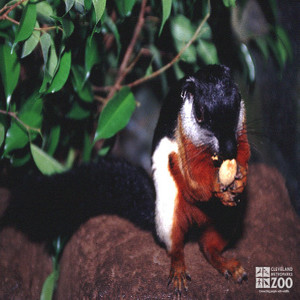Prevost's Squirrel
[Callosciurus prevostii]

The Prevost squirrel's head to rump length is 9 to 10 inches with a tail length of 8 to 9 inches, and a weight of 13 to 18 ounces. This is a very colorful animal whose name means beautiful squirrel. The top of the head, the back, the tail, and the sides are a glossy black, the underparts are reddish, and where the other colors approach each other on each side, there is a pure white line. The fur is fairly full but not particularly soft, and although the tail appears fairly full, it is flat as the underhairs are short. They have only four functional toes with fully developed claws on each foot. They do not have canine teeth, but have a pair of chisel-shaped incisors in each jaw.
Location: Animals Formerly at Zoo
Share:
Range
Prevost squirrel's range from the Malay Peninsula, Sumatra, Borneo, Bangka Island, Rhio Archipelago, Celebes, and nearby islands of East Indies.
Habitat
Being arboreal, Prevost squirrel's inhabit lowland and montane forest and cultivated areas.
Conservation Status
Least ConcernPrimary Threats
Gestation
3-6 weeks
Litter
3 or 4
Behavior
Diurnal, Prevost squirrels live single or in pairs. They live in hollow trees or construct nests of leaves and twigs in the branches of trees or large bushes. They generally do their foraging in the canopy or emergent layers of the forest. Their territory may overlap with other squirrels, and they have been seen eating side by side with Malayan giant squirrels. They coexist peacefully because they eat a smaller range of fruit than the larger animal, and their foraging pattern is different in that they need less food, spend less time looking, but they will travel farther to find it.
Reproduction
Prevost squirrels may mate throughout the year, the peak being April to June. The young will be born and reared in a special nest constructed high in the trees, probably as a defense against predators. They can have at least two, possibly more litters per year. The young are altricial.
Wild Diet
Fruit, nuts, seeds, buds, flowers, other vegetable matter, insects, bird's eggs
Zoo Diet
Staple: primate leaf eater pellets, hazelnuts (for teeth), small amounts grapes, apples, orange, banana, occasionally crickets, waxworms
